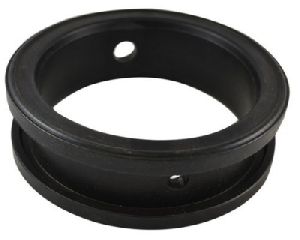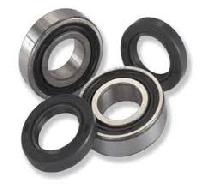
12 mm Grundfos Pump Seal
Get Price Quote
Known for its efficient performance and long life, this 12 mm Grundfos Pump Seal is high in demand in the global markets. The 12 mm Grundfos Pump Seal is available at the most competitive prices with us. Specifications Faces : SiC/SiC, Car/SiC, TC/TCElastomers : FKM, EPDM, NBR, SiliconHardware : SS316, SS316L, SS304

Inflatable Seal For Butterfly Valve
Get Price Quote
We offer inflatable silicon, neoprene & food quality rubber seal with reinforcement for butterfly valve. These are used in dense phase or pressure pneumatic conveying for fly ash handling system in coal fired boilers in power plant
Best Deals from Industrial Seals

Hydraulic Seal
Get Price Quote
We are offering hydraulic p u rod seal, wiper,u h s,piston seal,p t f e glyed,step seal,o.ring all types of industrial rubber goods.

Industrial Seals
Get Price Quote
Industrial Seals are used to create a barrier between a rotating and a stationary surface. They function to retain or separate lubricants or fluids, keep out contamination, and contain pressure. V-Ring seals are all rubber seals used primarily to exclude dirt and other contaminants. Wipers are flexible lip exclusion seals. They are used to wipe contaminants from a shaft. Scraper exclusion seals have a scraping edge that maintains contact with the rod regardless of any rod deflection or motion. Hydraulic seals and pneumatic seals are designed for the reciprocating motion that is common in hydraulic and pneumatic applications, such as cylinders. Rod seals & Piston seals are radial seals. The seal is fit onto a shaft with the sealing lip contacting the housing bore. Double acting or bi-directional seals are effective when sealing in both directions.Important dimensions to consider when specifying seals include shaft Outer Diameter or seal Inner Diameter, housing bore Diameter or seal Outer Diameter, axial cross section or Thickness, and radial cross section. Important service limits parameters to consider include maximum operating speed, maximum operating pressure, vacuum rating, operating temperature and any fluids with which they may come in contact. Rubber sealing element or lip material choices for seals include Aflas®, VITON, SILICON, HYPALON, EPDM, TPR, NBR, NEOPRENE, PTFE, PU, SBR& NATURAL. The hardness rating on a Shore A scale for Seals can be 30 ~ 95 Durometer. Exact specifications should be clarified by our engineers, as chemical and physical properties of Seals can differ based on manufacturing technique.

rubber v seal
Get Price Quote
Rubber ring for shafts requiring a dynamic seal (primary or back-up) in the axial direction. The body of V seals rotate with the shaft and holds itself in position by its elastic fit on the shaft. Sealing is produced by the contact between the lip and the counterface. Additionally, the V Series seal has good sealing action when the shaft is eccentric andor there is some misalignment. Combined with radial shaft seals, these axial face seal designs provide excellent excluding characteristics against all types of liquids, greases, oils, dirt, snad and other foreign materials.V-Rings are available in both Buna ‘N’ and Viton .

valve stem seal
Get Price Quote
valve stem seal, valve seal cap
silicone rubber seals
1 Per Piece

METAL STEAM LABY RINTH
Get Price Quote
our customers can purchase from us superior quality steam labyrinth for turbines and compressors. Manufactured using superior quality steel and metal alloys, these are known for their excellent finish. These are tested on variety of quality parameters by experts, in our advanced production unit.

polyurethane grade seal
Get Price Quote

Bearing Seal
Get Price Quote
Bearing Seal, cnc machined plastic, Solid Rubber Tyres, Taps, Washers

Rubber Oil Seals
Get Price Quote
Owing to our expert in this domain we are manufacturing and offering a wide gamut of Rubber Oil Seal to clients. Our Rubber O Rings are highly appreciated by the client of their high performance, superior quality, and durability. We use techniques and the finest quality materials that are obtained from trusted vendors for manufacturing excellent quality Rubber O Rings. Our team of professional experts checks these Rubber O Rings on different quality parameters to ensure smooth performance without any problems.

blue kastas pu seal
Get Price Quote
blue kastas pu seal, Pu Piston Seals, O Rings

round rubber seals
Get Price Quote
round rubber seals, auto rubber products, Rubber O Rings, o rings kit

Hydraulic Seals
Get Price Quote
Hydraulic Seals, Butterfly Valve, Dome Valve, neoprene viton rubbers

Plastic Security Seal
Get Price Quote
Plastic Security Seal

Oil Seal
Get Price Quote
Oil Seal, Hydraulic Seal, u seal, v seal, pu seal, O Rings

Rubber Diaphragms
Get Price Quote
Rubber Diaphragms, Rubber Grommet, Split Air Conditioners

Teflon Bellow Seal
Get Price Quote
Teflon Bellow Seal, Rubber Band, Rubber Sheet, Hydraulic Parts